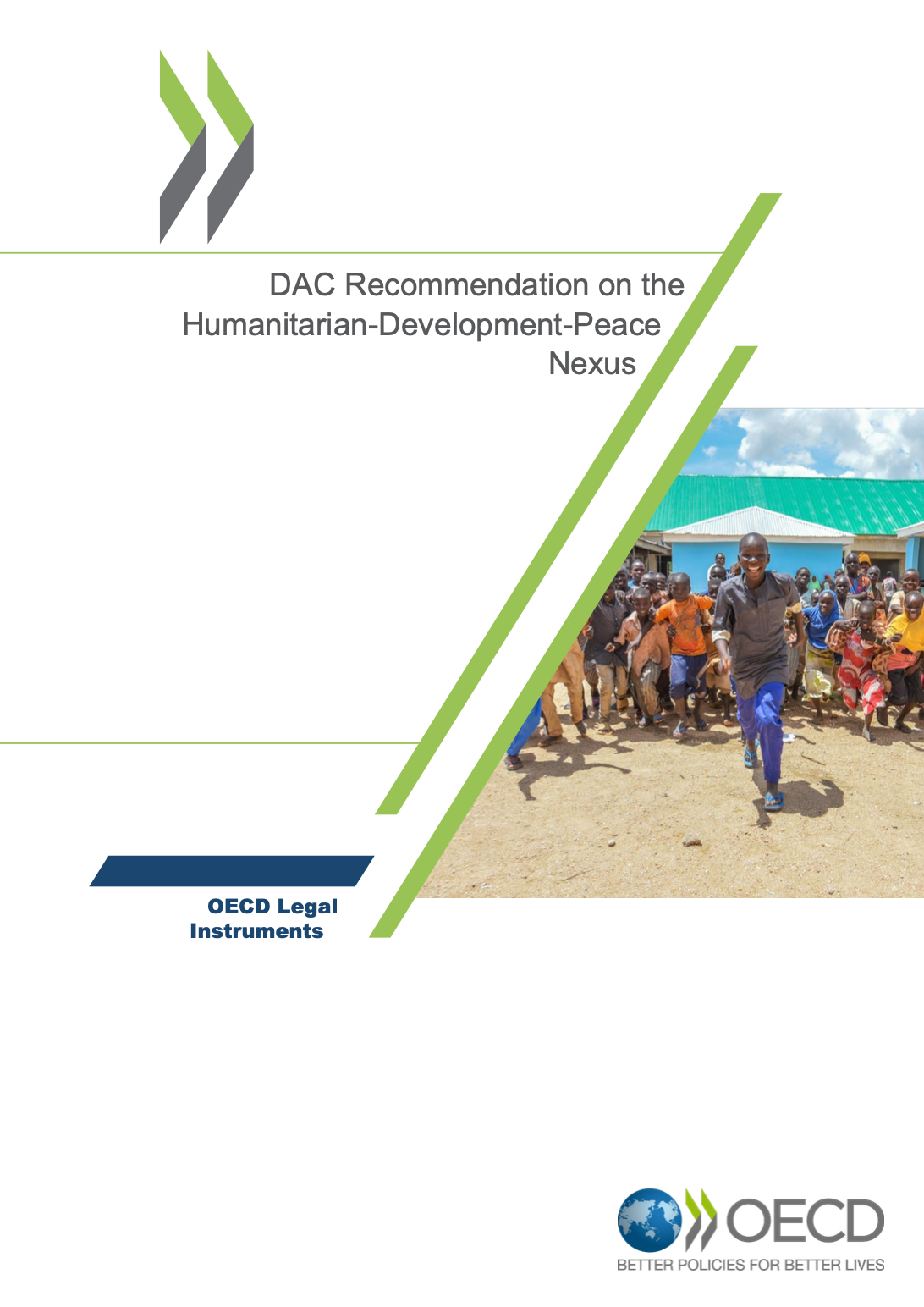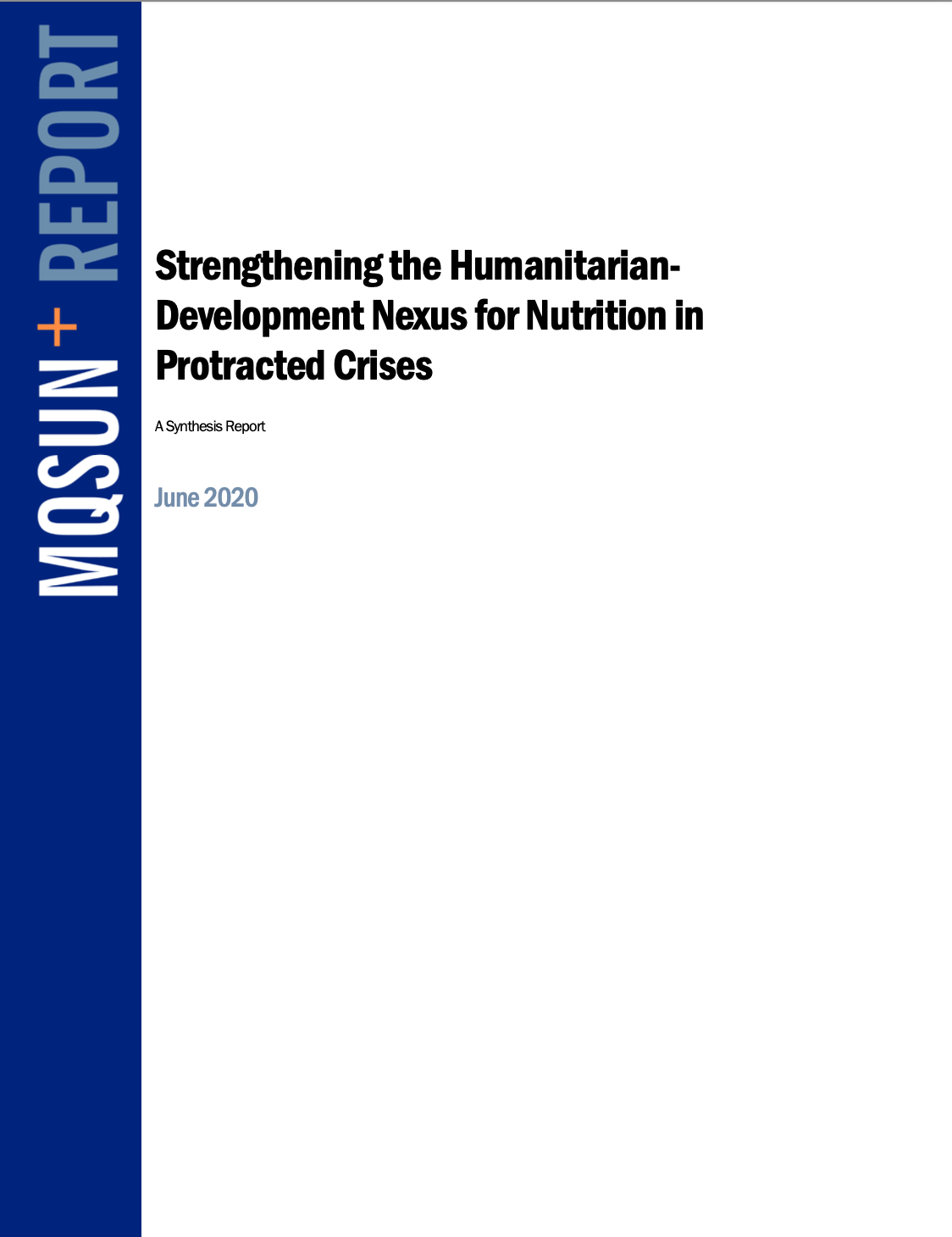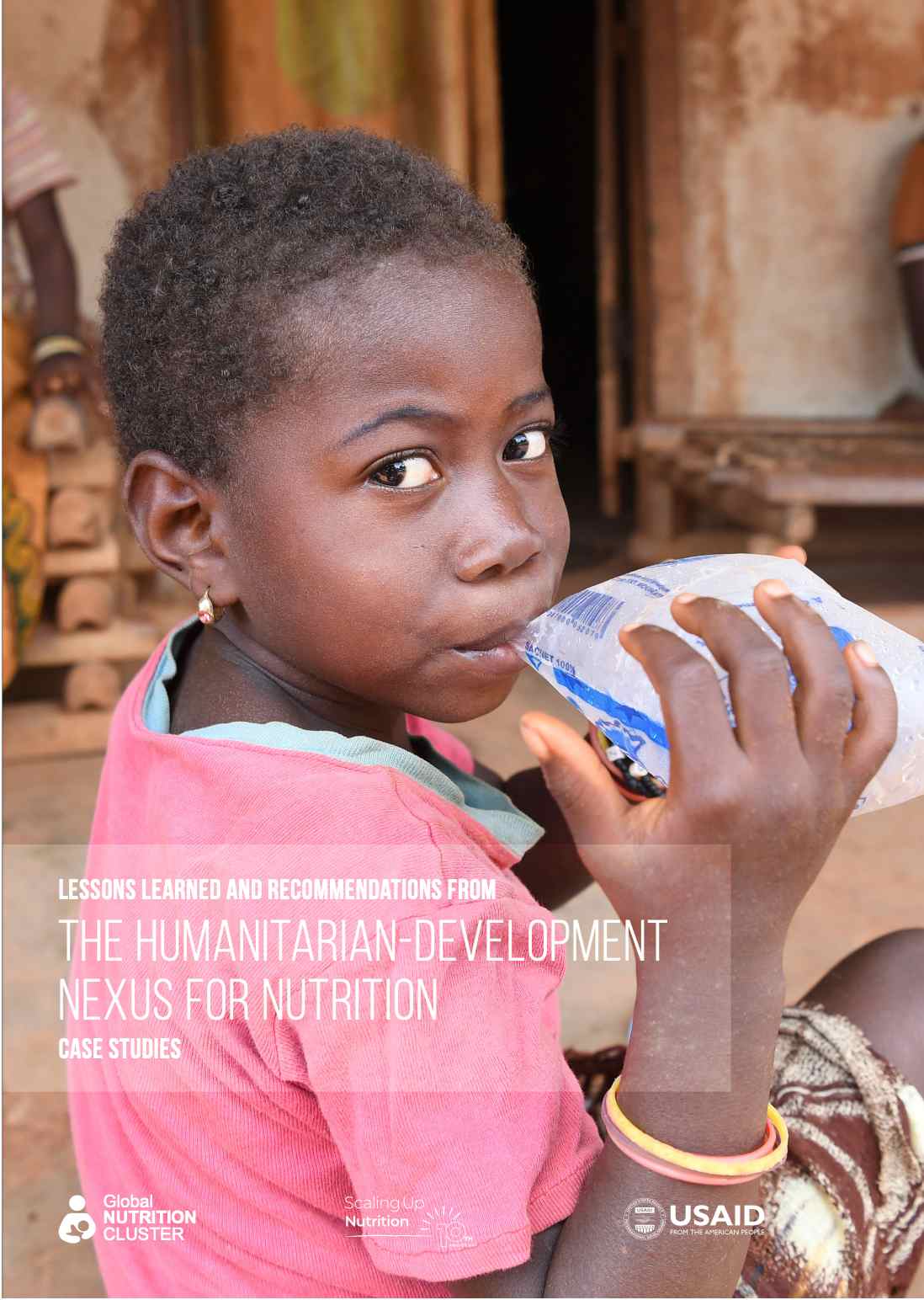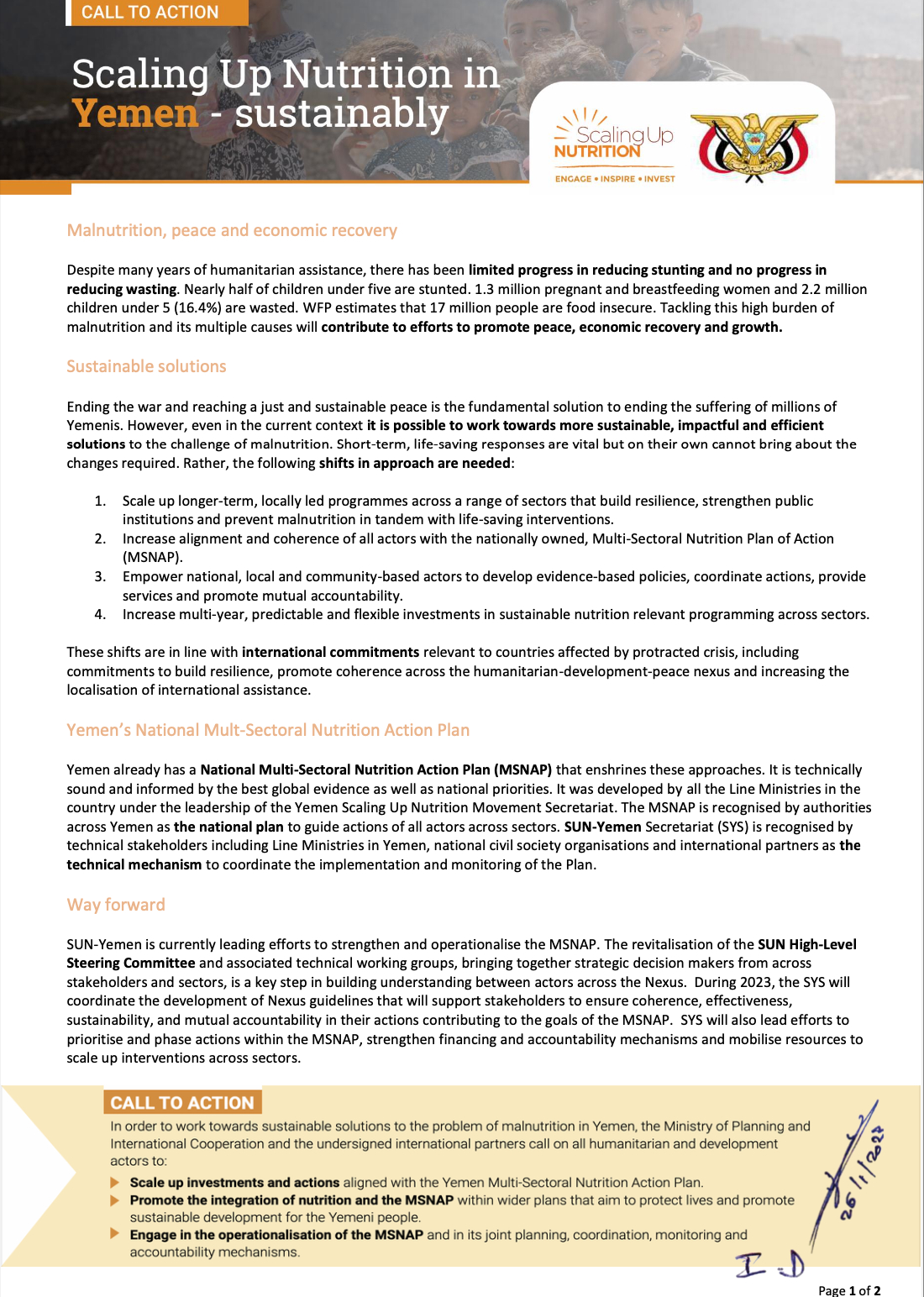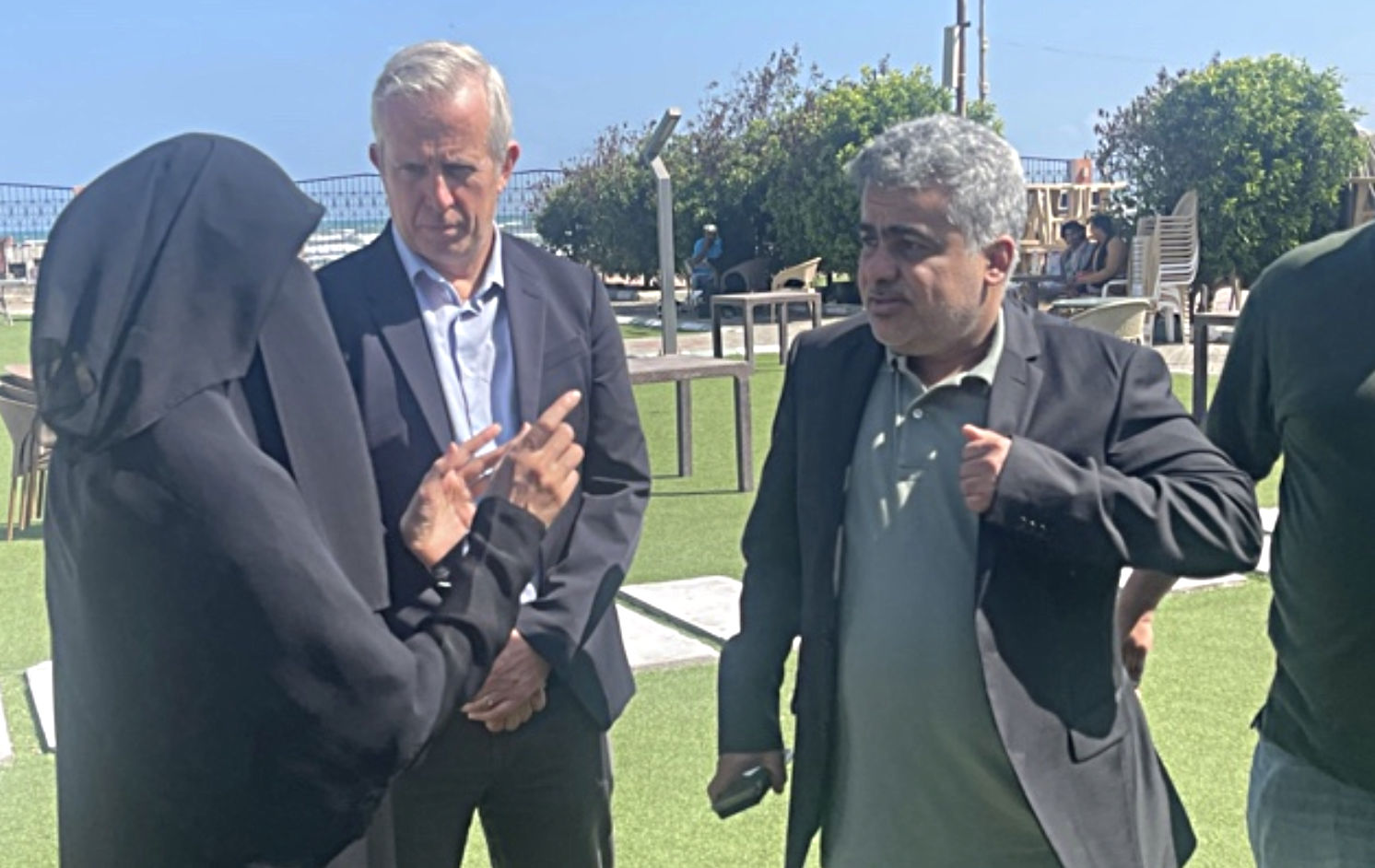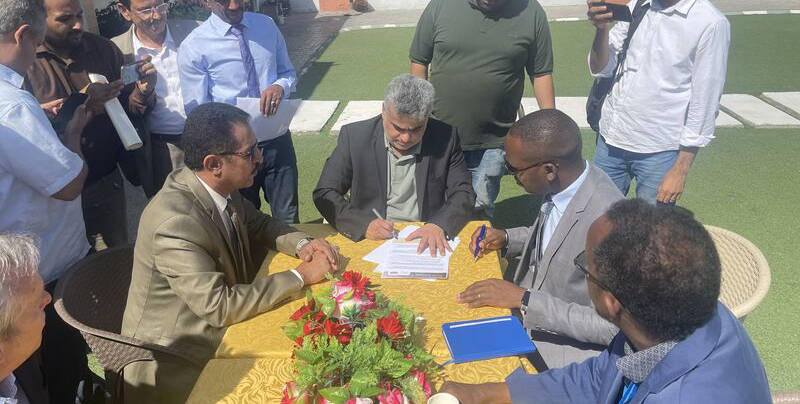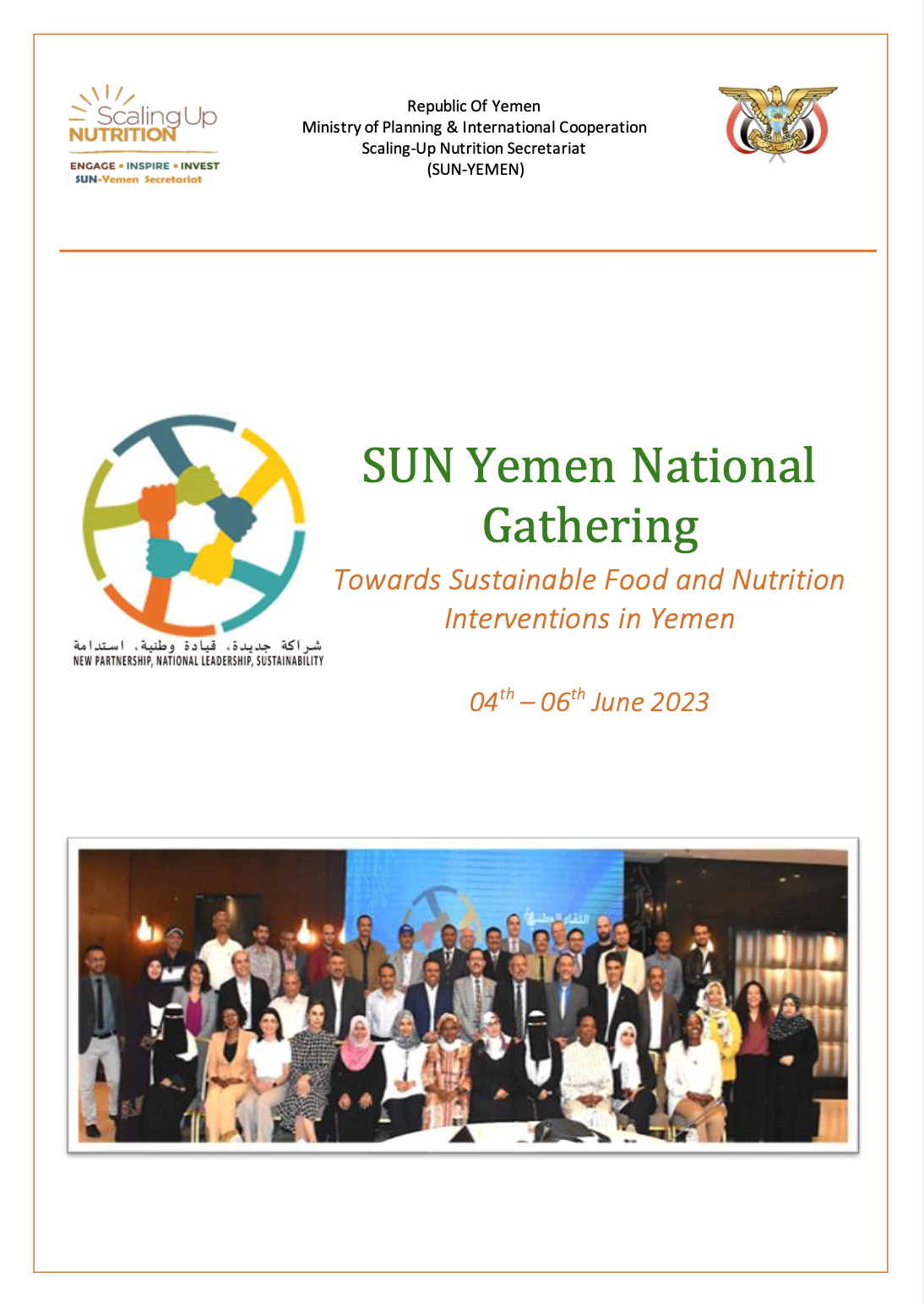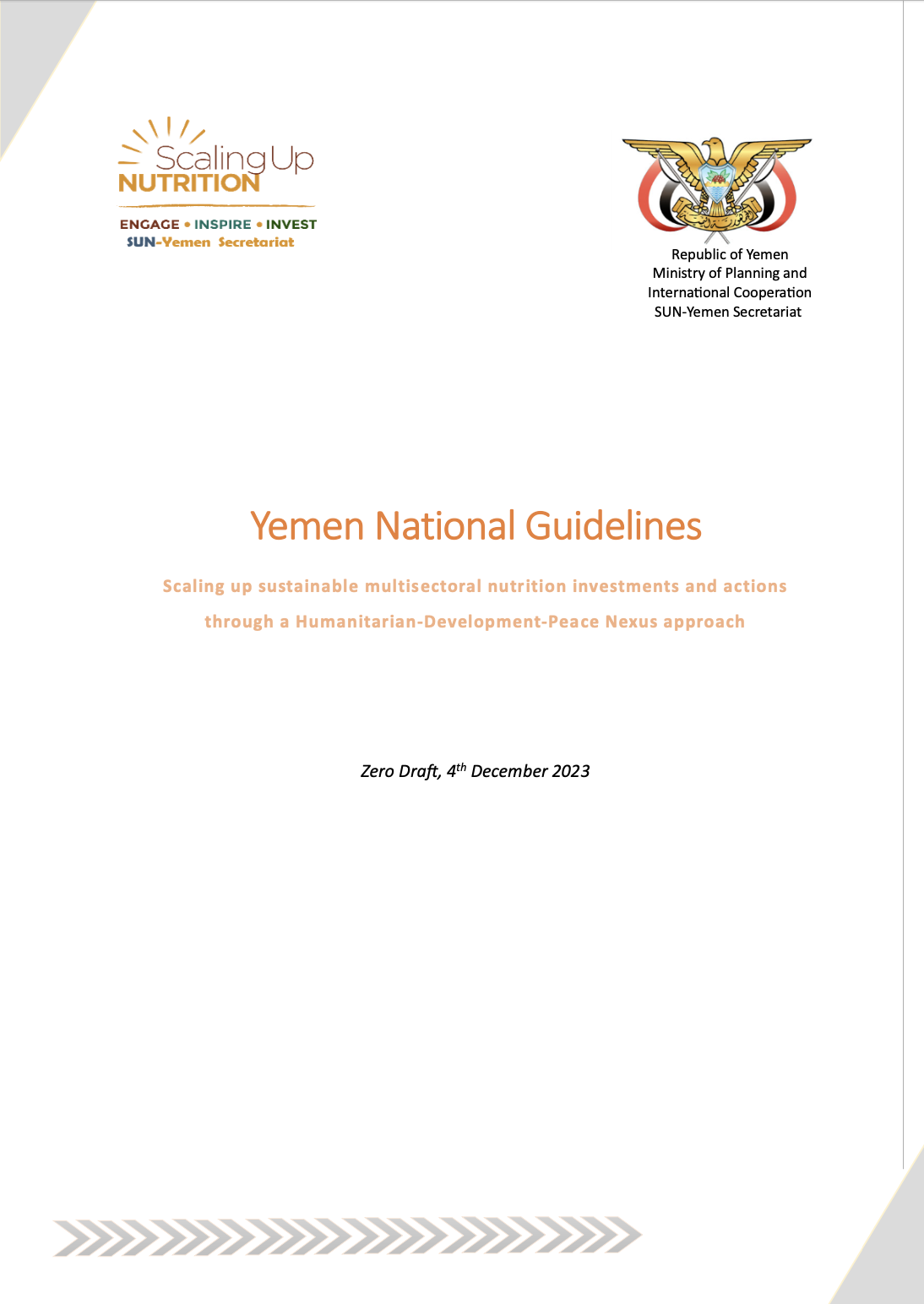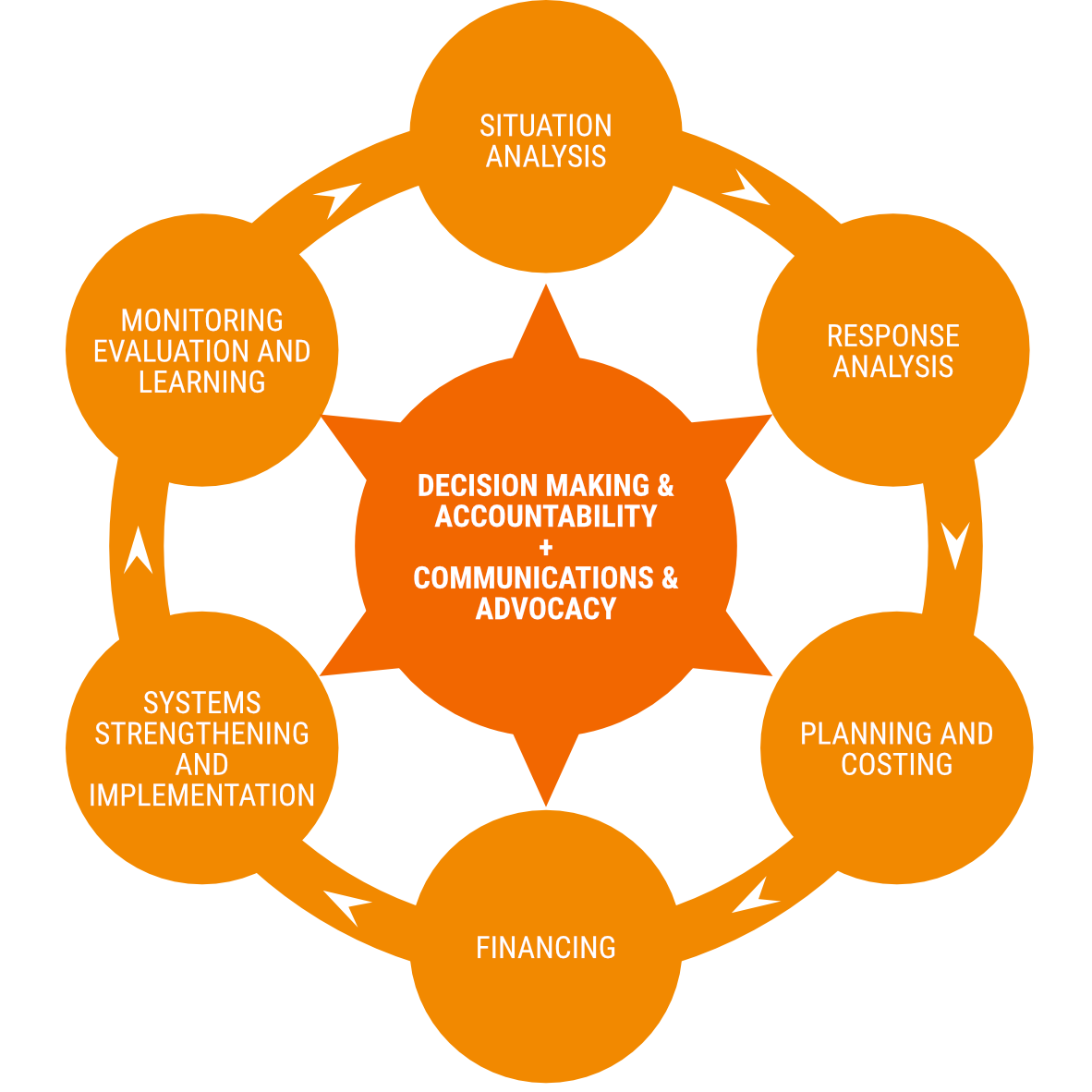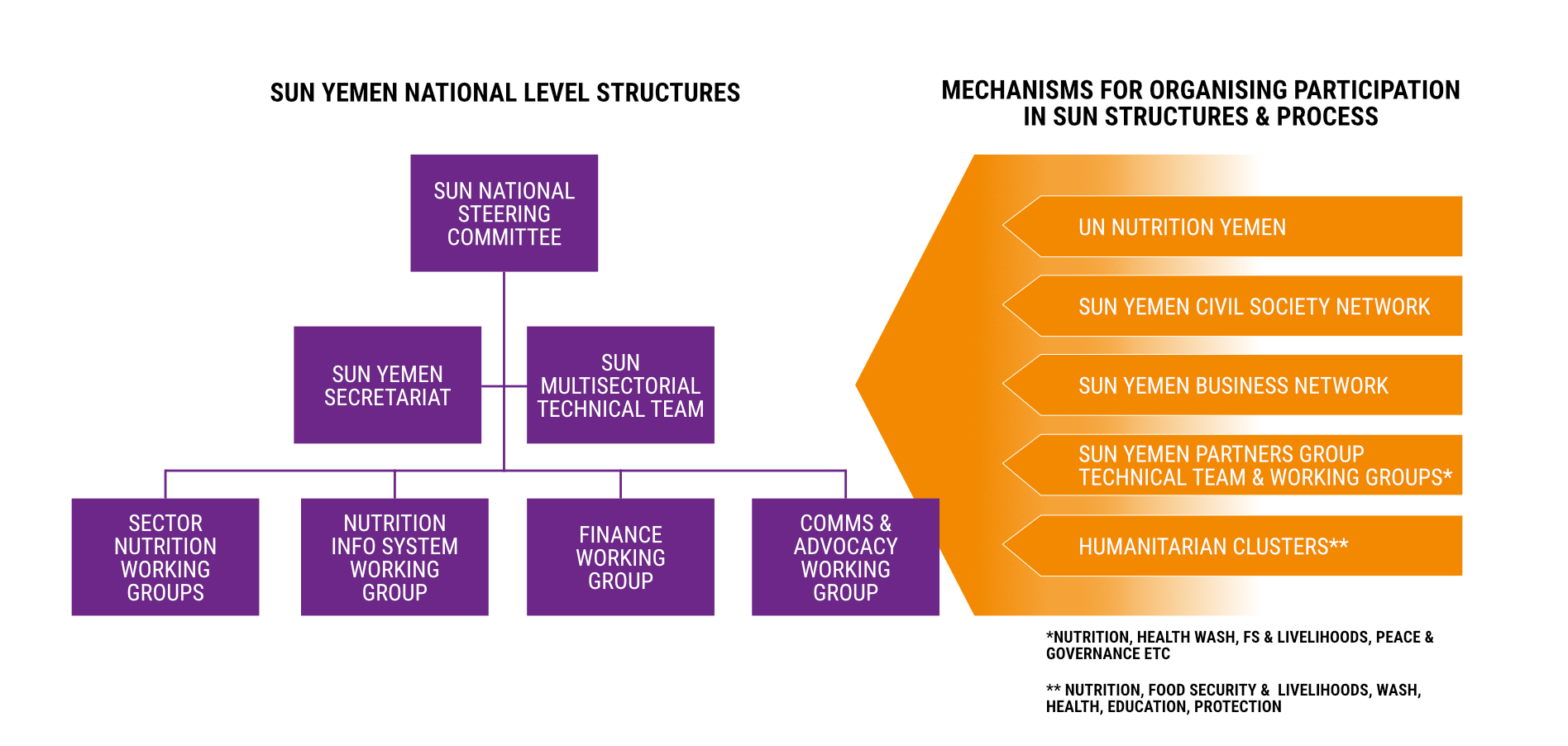N4D SUPPORT TO SUN YEMEN SECRETARIAT
1.0
Overview
CHILDREN REQUIRE HUMANITARIAN ASISTANCE
PEOPLE ARE INTERNALLY DISPLACED
PEOPLE NEED HUMANITARIAN ASSISTANCE
PEOPLE FACING FOOD & NUTRITION INSECURITY
%
CHILDREN AGED UNDER 5 YEARS ARE WASTED
%
CHILDREN AGED UNDER 5 YEARS SUFFER FROM MODERATE TO SEVERE STUNTING
Source: Yemen Humanitarian Needs Overview 2024 (Jan 2024)
SUN Yemen Secretariat
Scaling Up Nutrition (SUN) Yemen is a national-level Movement led by the Government that involves relevant humanitarian, development and peace-building partners (including UN agencies, donors, civil society and the private sector) in improving the nutrition of all Yemeni people.
The Movement is overseen by a multi-stakeholder Steering Committee and facilitated by the SUN Yemen Secretariat (SYS). The on-going political instability, fragmentation and conflict in the country has severely impacted SUN Yemen’s functioning but the Secretariat is in the process of strengthening its ways of working and performance.
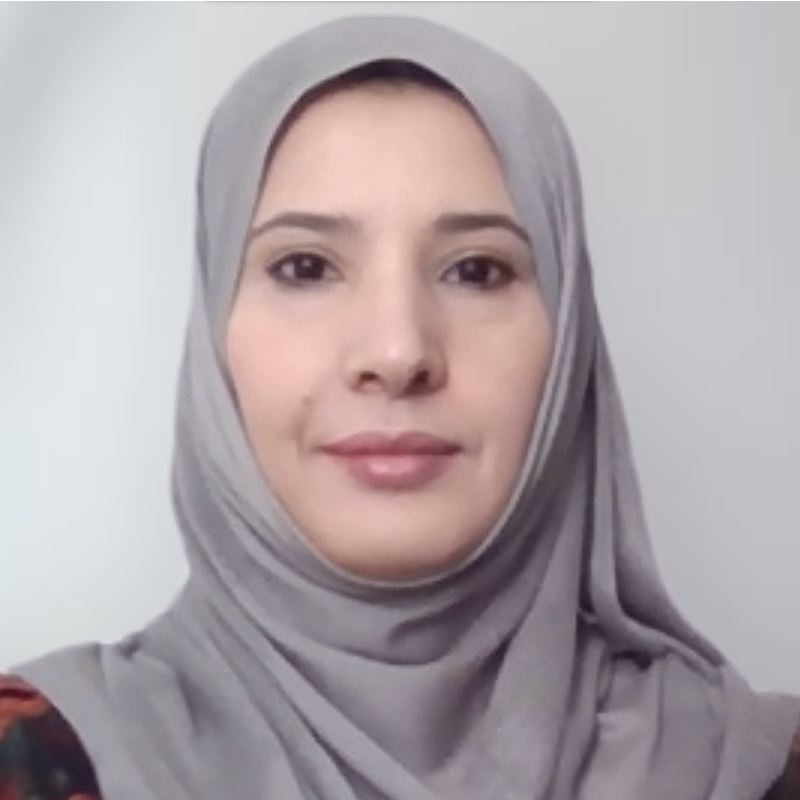
Karima Al-Hada´a
Planning & Liaison Specialist, SYS; Assistant National Food Systems’ Convenor; and Executive Committee member, global SUN Movement
LISTEN TO KARIMA SPEAK ABOUT SUN YEMEN WORKING WITH LOCAL ACTORS
1.1
Key characteristics of a NEXUS approach to nutrition
A HDPN approach to nutrition is guided by wider HDPN approaches such as the OECD DAC Recommendation on the Humanitarian-Development-Peace Nexus (see pdf download below).
N4D defines a HDPN approach for nutrition as:
“… [when] all humanitarian, development and peace actors draw on their comparative advantages and work in collaboration and coherence with each other, under national leadership, in order to achieve the collective outcome of sustained improvements in nutrition for all people. All stakeholders align with national and sub-national priorities as outlined in one overarching, national and multisectoral nutrition action plan.”
Key elements of a HDPN approach:
- Collective outcomes to sustainably reduce needs, risks and vulnerabilities by preventing, preparing and responding to malnutrition;
- Collaborative and coherent ways of working between humanitarian, development and peace-building actors;
- Drawing on respective comparative advantages; and
- Convergence of HDPN actions on the same at-risk populations.
Learn more
DAC Recommendation on the OECD Legal Instruments Humanitarian-Development-Peace Nexus (pdf)
Strengthening the Humanitarian-
Development Nexus for Nutrition in Protracted Crises (pdf)
Lessons learned and recommendations from
the humanitarian-development nexus for nutrition (pdf)
1.2
The Yemen Context
Political
The country of Yemen as it exists today was formed in 1990 when North Yemen (the “Yemen Arab Republic”) and South Yemen (the “People’s Republic of South Yemen”) were unified.
Key events since 2011
2011 – Mass protests result in President Saleh agreeing to hand over power to his deputy, Abdrabbuh Mansour Hadi.
2014 – The Houthis, also known as Ansar Allah, take over the capital Sana’a, leading to a prolonged escalation in the civil war.
2015 – Saudi Arabia leads international military coalition against the Houthis.
2018 – Southern Yemeni separatists, the Southern Transitional Council – backed by the United Arab Emirates – seize control of Aden, the main city in the south.
2019 – STC and government sign power-sharing agreement to end conflict in southern Yemen.
2022 – President Hadi resigns and hands over power to the Presidential Leadership Council.
(Source: https://www.bbc.com/news/world-middle-east-14704852)
As of today, large parts of the north are controlled by the Houthis and the rest of the country by the Internationally Recognised Government.
Humanitarian
After nine years of conflict, the needs in Yemen remain immense. A political agreement, leading to sustainable peace, is the only long-term solution to the humanitarian crisis in Yemen.
In 2024, 18.2 million people need humanitarian assistance and protection services. 17.6 million people are facing food and nutrition insecurity.
4.5 million people remain displaced, many of whom have experienced multiple displacements over several years.¨
(Source: 2024 Humanitarian Response Plan)
Nutrition
Nearly half of all children under five suffer from moderate to severe stunting.
1.3 million pregnant and breastfeeding women and 2.2 million children aged under 5 years (16.4 per cent) are wasted
Stunting and wasting trends (2003 - 2022)
Source: UNICEF Yemen Country Office
Data sources: 2003 (PAPFAM); 2005 (HBS); 2011 (CFSS); 2013 (DHS); 2018 & 2020 (mixed sources)
1.3
Humanitarian, development and peace financing in Yemen
In the past, the predominant form of finance to Yemen has been channelled through the humanitarian system. However, development financing has been increasing and outstripped humanitarian aid in 2022, while spending on peace-building remains low.
Source: States of Fragility
SCALING UP DEVELOPMENT INTERVENTIONS ALONGSIDE HUMANITARIAN INTERVENTIONS
“There needs to be a shift in focus to scaling up actions in different sectors that address the underlying causes and prevent malnutrition, alongside actions that meet immediate needs and treat malnutrition. There are already examples of these ‘Nexus in action’ programmes in Yemen – and there are also opportunities to scale them up in many parts of the country…”
From N4D Directors in conversation
TIMELINE OF ACTIVITIES TO ADDRESS MALNUTRITION
IN YEMEN (PRE-2022)
2013-14
2013
YEMEN JOINS SUN MOVEMENT
2015
ESCALATION OF CONFLICT
Conflict intensifies between the Houthi rebels in the North and a Saudi Arabian-led force in the South (see more in political context above)
2018
MSNAP UPDATED
2020 ONWARDS
INTERMITTENT ACTIVITIES
2.0
Nexus approach in action
2.1
Understanding the context and developing a Roadmap
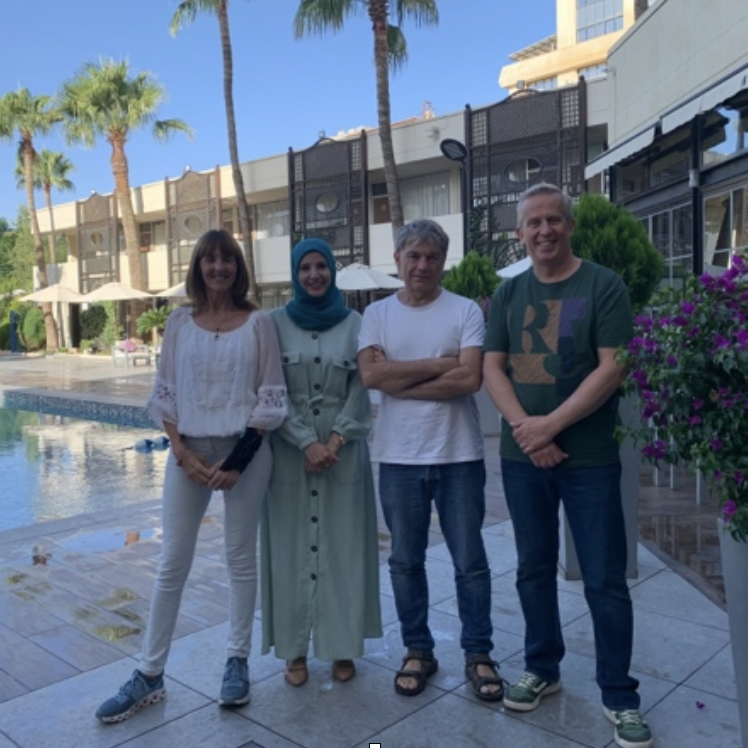
N4D team visit to Amman, Jordan in August 2022
This involved crucial in-person discussions with Karima Al-Hada´a, SYS coordinator, as well as key actors from UN and donor agencies
N4D´s first (and on-going) task was to develop an in-depth understanding of efforts to scale up multisectoral nutrition actions in Yemen, including: the roles and approaches of local, national and international humanitarian and development actors; and the relationships between these actors and the factors enabling or hindering them working together in a coherent and effective way. Discussions with key individuals from SYS, the Ministry of Planning and International Cooperation, other relevant line ministries, and local and international partners provided insight into the current HDPN context in Yemen. From these consultations, SYS with support from N4D developed a Roadmap for scaling up implementation of the MSNAP.
KEY RESULTS
- Organized in-person meeting in Amman, Jordan between N4D and key stakeholders (August 2022)
- Developed Roadmap to ‘operationalize’ the MSNAP (September 2022)
SUPPORTING LOCAL AND NATIONAL ACTORS TO LEAD
“N4D’s experience in Yemen highlights that, as an international aid system, we need to get much better at identifying and supporting the local and national actors that are responsible at a technical level for coordinating and leading the implementation of policies and services.
This often doesn’t happen due to the understandable focus on delivering programmes to save lives, as well as concerns about diverting aid or legitimizing unconstitutional political authorities. But if we want more sustainable solutions, we need to improve on this, whilst mitigating any risks.”
From N4D Directors in conversation
LEARN MORE ABOUT CONTEXT & DEVELOPING THE ROADMAP
International support for nutrition has focussed on saving lives and treating malnutrition through short-term humanitarian assistance, in line with overall financing trends highlighted above. There has been an inadequate focus on prevention of malnutrition through longer-term development policies and programmes. Humanitarian assistance is often provided through public service delivery systems (e.g. UNICEF support to health facilities) but usually with inadequate strengthening of national and local public coordination, planning and service delivery systems and capacities.
N4D found limited awareness among international actors of the MSNAP and the role of SUN Yemen, in part due to high turnover of international staff (especially during the COVID-19 pandemic). It was also clear that a general mistrust of Yemeni actors, the need for humanitarian actors to maintain independence and a lack of proactivity in understanding the nuances of the national political and institutional landscape were other factors contributing to this lack of awareness. Consequently, multi-stakeholder coordination mechanisms and processes for nutrition that had been established prior to the conflict were no longer functioning.
|
What are the factors hindering progress? > No shared vision of the HDPN for nutrition, especially its benefits and areas of convergence; > Some actors were unaware of the MSNAP’s existence or of its history (e.g.,individuals involved in the 2019 revision process were no longer in place); > View among some stakeholders that SUN Yemen and the MSNAP did not represent represent the whole of the country due to the political situation and situating of SUN Yemen Secretariat in Sana’a; > Lack of investment in nutrition and disaster preparedness and response; > Some organizations are not able to participate and to bring their potentially valuable inputs due to the lack of resources. |
What are the factors enabling progress? > Political commitment for nutrition, with relevant policies, strategies and coordination mechanisms in place; > Colocation of humanitarian and development actors in priority areas and in the public health system; > Increasing flexibility from financing instruments; > Huge amount of investment through the humanitarian system and the Humanitarian Response Plan, not just under the nutrition cluster but other sectors as well, and admirable efforts to have inter cluster multisectoral approach to nutrition under the humanitarian response through the Integrated Famine Risk Reduction plan; and > Nutrition cluster overseeing the coordination of large investments through the health system and working with health structures at community, district and governorate levels to implement nutrition relevant responses. |
2.2
Implementing the Roadmap
Raising awareness and promoting engagement of stakeholders in SUN Yemen processes
N4D supported SYS in raising awareness of the MSNAP, its multi-stakeholder governance arrangements and SYS’s own role; and in developing trust among all stakeholders by facilitating meetings and dialogue. N4D also facilitated the Geneva visit of MoPIC’s vice minister and members of SYS to meet the global SUN Movement Coordinator, SUN Secretariat and SUN networks in November 2022. These advocacy efforts helped to revitalize participation and interest in the SYS Steering Committee, which met in January 2023 in the UN Resident Coordinators’ Office. The outcome of this meeting was the Call to Action.
CALL TO ACTION | KEY POINTS
> Scale up investments and actions aligned with the Yemen MSNAP
> Promote the integration of nutrition and the MSNAP with wider plans for protecting lives and promoting sustainable development
> Engage in the operationalization of the MSNAP and its joint planning, coordination, monitoring and accountability mechanisms
Promoting the integration of nutrition in wider policies and processes as a priority
N4D engaged with senior officials and technical staff in Yemen for promoting the integration of nutrition, the MSNAP and its governance structures into wider processes, including the work of the newly-established Yemen Partners Group (YPG), which aims to promote sustainable solutions and greater coherence between humanitarian and development efforts. N4D successfully advocated for establishing a Yemen Partners’ Nutrition Working Group under the high level YPG and contributed to its terms of reference. All these efforts resulted in the SUN Yemen National Gathering in Amman, Jordan in June 2023, attended by 57 in-person participants, including representatives from the north and south of the country; and 35 virtual participants from the private sector, UN agencies, NGOs and donors.
SUN YEMEN NATIONAL GATHERING | KEY OUTCOMES
CONTRIBUTING TO PEACE BUILDING EFFORTS
“The SUN Yemen Secretariat has demonstrated its ability to facilitate technical dialogue across the political divides in the country. This was clearly demonstrated in the SUN Yemen National Gathering in June 2023, which brought together technical focal points from line ministries in both Aden and Sana´a to identify priority actions for addressing malnutrition throughout the country. In some small way, this kind of technical dialogue can contribute to building trust and joint working that provides building blocks for wider efforts to build peace…”
From N4D Directors in conversation
KEY RESULTS
- Stronger engagement by international partners in SUN Movement Secretariat’s Yemen-led processes
- Developing joint Call to Action
- Establishing Yemen Partners’ Nutrition Working Group (within wider Nexus structures)
- Organizing SUN Yemen National Gathering in June 2023
2.3
Developing National Guidelines and updating the MSNAP
National Guidelines on a Nexus approach to nutrition in Yemen
The SUN Yemen National Gathering was a key event for shaping the SUN Yemen National Guidelines. During the Gathering, principles and ways of working were identified that have provided a foundation for the guidance. The main purpose of the Guidelines is to inform the policies and practices of all humanitarian, development and peace stakeholders with a role in implementing the Yemen MSNAP and improving the nutrition situation of all Yemeni people. The process of developing the Guidelines involved a literature review of Nexus approaches in general and nutrition in particular, as well as consultations with all stakeholders for their inputs and commitment to working in line with the Guidelines.
Source: SUN Yemen National Guidelines. Please click each image to enlarge diagrams.
Updating the Multisectoral Nutrition Action Plan 2024-2030
N4D is working with the SUN Yemen Secretariat and its partners to update the MSNAP for the period 2024-2030. The updated plan will have a strong focus on scaling up prioritised interventions in different sectors for preventing malnutrition, alongside humanitarian assistance aimed at addressing immediate causes and treating malnutrition. In addition, a major aim will be to strengthen the capacities of line ministries as well as Yemeni civil society organisations for implementing services and interventions.
KEY RESULTS
- Clarifying joint structures for a Nexus approach
- Agreed ways of working between humanitarian, development and peacebuilding actors.
- Working together on updating the MSNAP
TURNING THEORY AND RHETORIC INTO REALITY
“It’s clear which strategic shifts are needed. The current process to update the MSNAP provides the opportunity to translate these changes into reality. We need to focus on identifying priority geographical areas and interventions across different sectors, and ways of strengthening the capacities of local and national actors to implement them…”
From N4D Directors in conversation
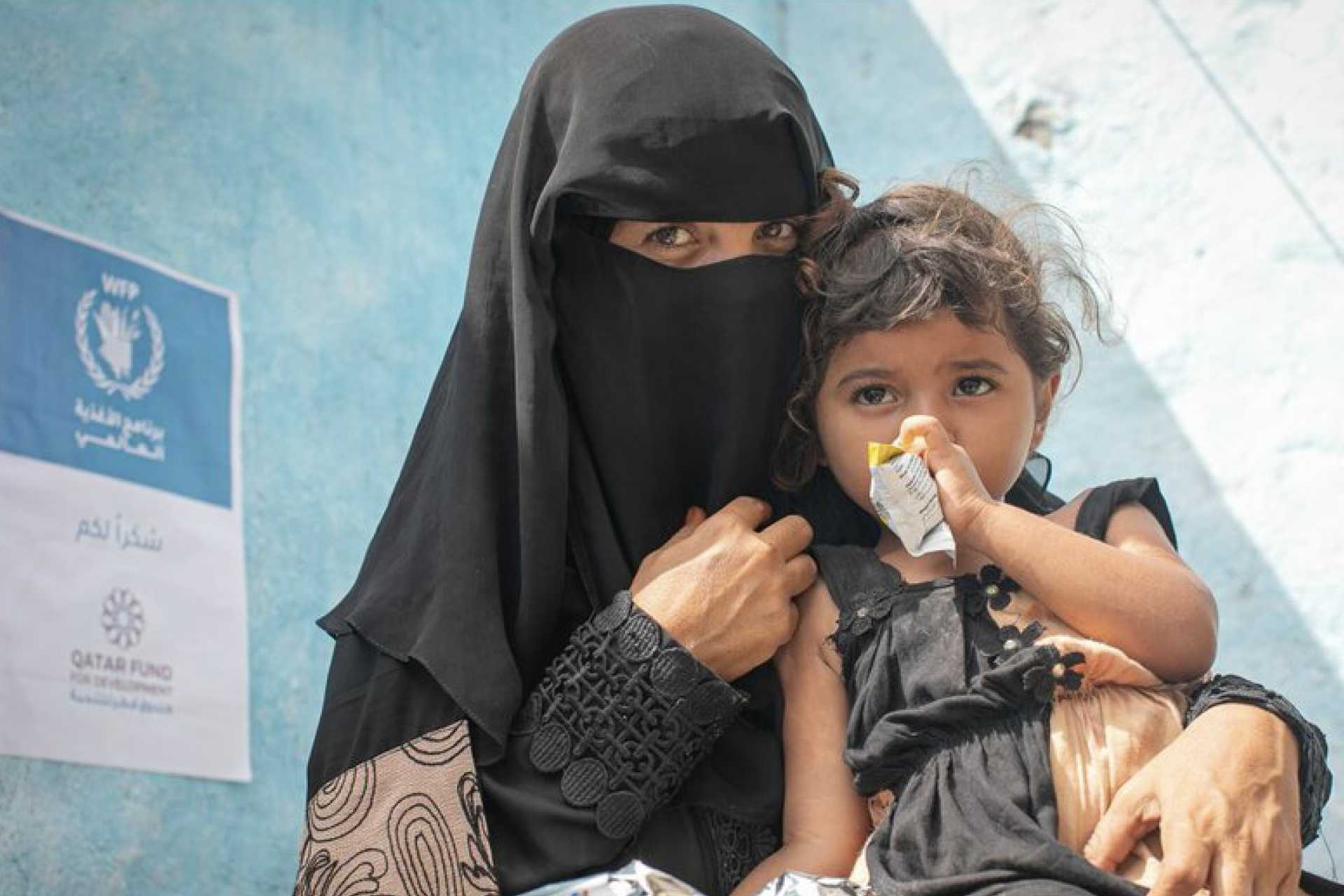
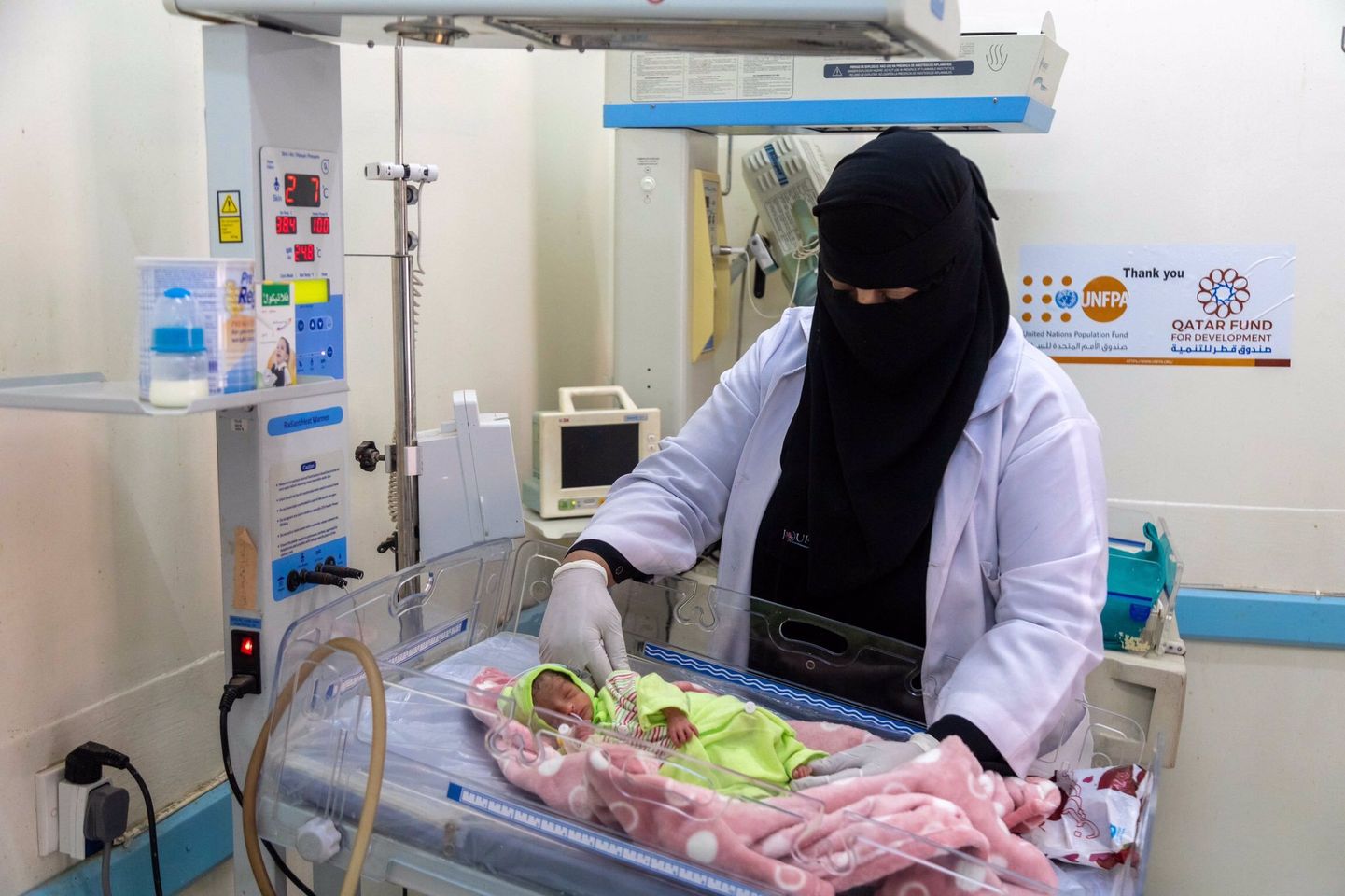
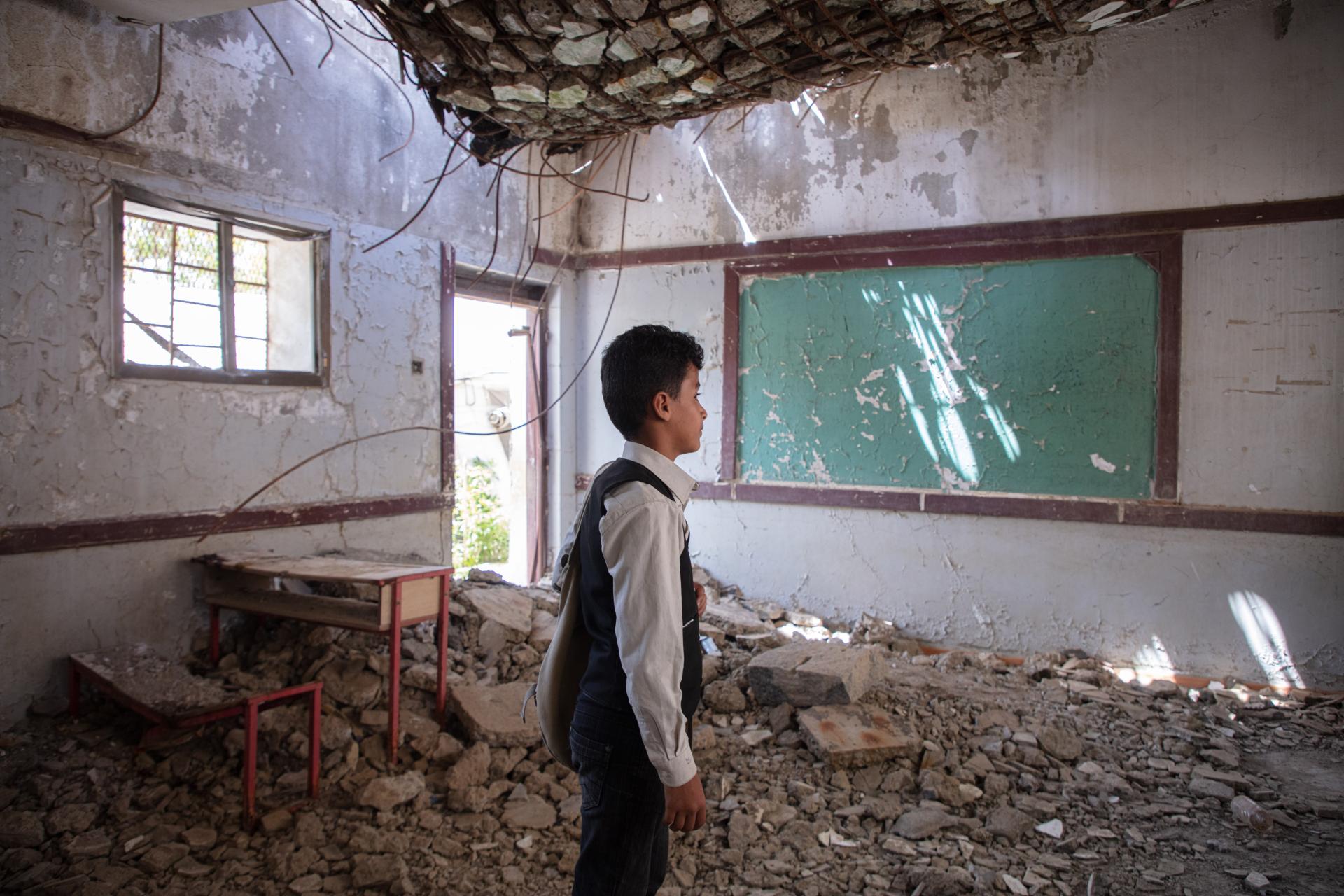
3.0
Achievements & lessons learned
3.1
What has been achieved?
There is still considerable work to be done in turning increased commitment for engaging with SUN multistakeholder processes into action that results in increased, longer-term financing and scaled-up multisectoral programmes – that ultimately lead to improved and more sustainable nutrition outcomes.
However, substantial progress has been made in paving the way for these strategic shifts and outcomes.
1: Increased awareness, trust and multi-stakeholder engagement
2: Nutrition and the MSNAP are regarded as priorities
3: Strengthened coordination and collaboration between stakeholders across the Nexus
4: Strengthened capacity of SUN Yemen to coordinate and support across sectors and stakeholders
3.2
Lessons learned
What worked well? Less well? What has hindered progress?
The lack of awareness and mistrust of stakeholders in relation to SUN structures and processes in Yemen has been a major constraint to making progress. This was due in part to high staff turnover but also to a lack of proactivity in mapping, analysing and understanding the national nutrition landscape. This includes identifying local and national actors with the necessary values and legitimacy for leading efforts to scale up nutrition actions at different levels. A further exacerbating factor is the understandable pressure on staff to deliver according to their own agency mandates and priorities, thereby limiting time and resources for ensuring inter-agency collaboration and coherence.
Lessons learned: How to promote multi-stakeholder engagement across the Nexus and support more locally led processes for scaling up multisectoral actions for nutrition
Ensure time & resources to develop a deep understanding of the context
This includes a political economy analysis to understand the interests of different stakeholders and the power dynamics between them.
Understanding and trust are vital for collaboration
Don’t assume that stakeholders are aware of existing national policy frameworks and institutional arrangements. Mistrust is often a result of a lack of engagement, and it’s important to take time to understand the perspectives/objectives of local and national actors.
Employ a participatory process for developing a joint Roadmap
This is essential for turning commitments into joint actions but there is also a need to build in flexibility for responding to the needs, circumstances and inputs of different stakeholders.
Provide proactive support...
But work from behind the scenes as much as possible to enable local and national actors to properly take the lead.
Be assertive in highlighting gaps between agency commitments, policies and practices
N4D’s experience is that agencies usually react positively when such gaps are highlighted and recognize that better progress needs to be made.
Don’t be afraid to ask!
People and agencies are often willing to step up and play their roles within joint multi-stakeholder efforts. For example, the UN Resident and Humanitarian Coordinator in Yemen and his team have become strong advocates for nutrition and SUN-led processes.
4.0
Next Steps
The updated MSNAP 2024-2030 will be finalised by September 2024. Thereafter, a key aim will be to mobilise the required resources and to enhance actions to strengthen the capabilities of Line Ministries and Yemeni civil society organisations working in different sectors to scale up implementation.
A further priority will be to establish the National Nutrition Information System within the SUN Yemen Secretariat that will provide a basis for monitoring, evaluation, learning, accountability and updates to the plan.
This page will continue to be updated with content and other supporting documents as the project progresses. We welcome any feedback and are always keen to engage in discussion.
All main images © Unicef. Other images N4D.


